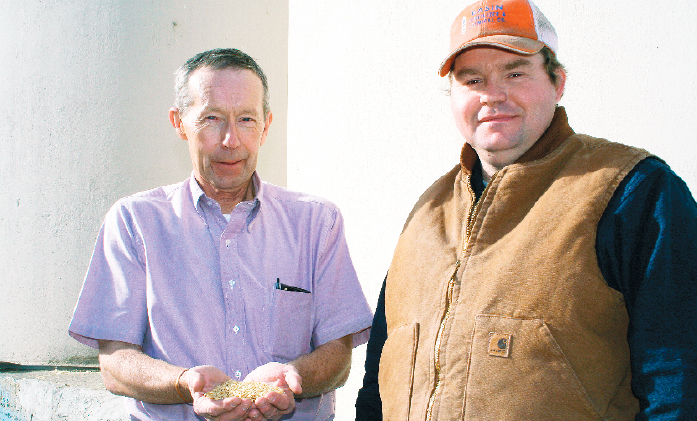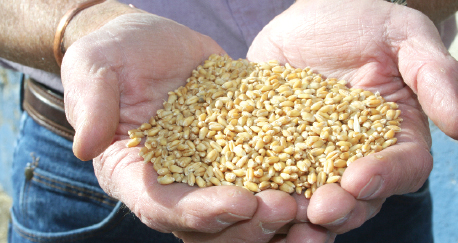This was an exceptional
year for North State wheat growers

J.W. Cope, left, a grain merchant for
Winema Elevators in the
Klamath Basin, and Tony
Alexander, manager of
Stronghold Elevator in
Tulelake, report that
there was strong
interest in growing
wheat this year in
Northern California.
Photo/Kathy Coatney
 Ideal
growing conditions in California’s northern
intermountain region this year resulted in a
bountiful harvest of high quality wheat.
Ideal
growing conditions in California’s northern
intermountain region this year resulted in a
bountiful harvest of high quality wheat.
Photo/Kathy Coatney
Wheat growers in California's northern
intermountain region enjoyed bountiful
harvests this year as a result of
exceptional growing weather and an ample
water supply.
"It was the best grain-growing weather we
could have imagined. When the grain was in
its active growth state, we had only a few
days over 90 degrees, and we were hardly
over 95 degrees," Etna farmer Brandon Fawaz
said.
Grain really shuts down its growth when
temperatures rise above 90 degrees,
especially 95 degrees, Fawaz said: "High
temperatures will really set it back, and we
never had those temperatures this year."
The intermountain regions have a limited
growing season. In Scott Valley, for
example, there is an average of only 140
frost-free days each year, said Jim Morris
of Bryan-Morris Ranch in Etna.
The restricted growing season also limits
planting choices for farmers, Morris said.
"In the past it's been forages and cereal
grains, and now a lot more cereal grains,"
he said.
Steve Orloff, University of California
Cooperative Extension farm advisor, said
growers in the intermountain areas typically
raise more hay, with grain being a
rotational crop.
One reason is that frequently raising
grain turns out to be a losing proposition
for growers, Orloff said.
"It's just kind of a necessary evil. They
just break even and want to get into alfalfa
again," he said.
This year, however, the increased grain
prices resulted in additional interest in
growing hard red spring wheat.
"We've got more grain growing this year
than we traditionally do," Orloff said.
J.W. Cope, a merchant for Winema
Elevators in the Klamath Basin, another
intermountain region, said he's seen an
increase in wheat acreage and in grain
production overall in his area, too.
Whether this increased acreage continues
in subsequent years will depend in part on
grain prices and an adequate water supply,
Cope said. In his region, the acreage is
determined by the water availability, and
this year growers had adequate water to
justify full planting, he added.
The Klamath Basin had a high yield and
good-quality crop, too, Cope said.
"Some people got the best yields they've
ever seen," he said, adding the higher
yields and quality were due to the cool
summer and lack of severe frost in
September.
With the price of grain so high, Morris
and other growers in his area are harvesting
grain for grain, he said.
"That's a change for our area. It hasn't
been that way," Morris said. "A lot of
people are growing dual- purpose grains or
awnless grains, which means they can harvest
grain for grain or cut it for hay depending
on the best market. That wasn't the way the
world worked in the past, but it is today.
Stuff moves really quickly."
Morris has seen firsthand how quickly the
market can turn, recalling how he had great
difficulty selling his hay in 2009.
Currently, Morris is growing a high protein
hard red spring wheat and that market is
very strong.
"We can do it here, and we can get the
protein where it needs to be. So until that
market turns around, I think that's where we
are for a little while," he said.
Fawaz said he has found raising grain for
grain was much more feasible for him than
grain hay, for several reasons. First, grain
can be shipped out of the field, so it
doesn't have to be stored, and growers are
paid right away, Fawaz said.
"Most farmers in this area are always
tight on their hay storage space," Fawaz
said, so putting 10 to 20 percent of their
ground into grain production frees up 10 to
20 percent of their hay storage.
Another advantage with raising grain for
grain is it can be inexpensively insured
against frost, hail or fire damage, Fawaz
said.
The cost of harvesting grain for grain is
much less versus grain hay, Fawaz said.
"I do custom harvesting and charge
anywhere from $40 to $45 an acre to custom
harvest grain. And typically we run two and
a quarter to three tons of grain per acre,
and that's a fixed price of $40," he said.
With grain hay, there is usually double
the amount of hay compared to grain, five to
six tons per acre, Fawaz said. He estimates
on six-tons-to-the-acre grain hay, harvest
costs would be about $180 an acre to custom
harvest.
Fawaz said he feels grain is far more
forgiving in terms of weather.
"When the grain's ready to harvest, if a
thunderstorm comes, you get a little
rainshower, we'll let it dry out, and then
we'll go back to harvesting," he said,
adding that isn't the case with grain hay.
Fawaz sees two advantages to planting
grain hay. The first is for fall planting of
alfalfa. Fall alfalfa has to be planted by
Aug. 25, and getting grain harvested by
then, and getting all the field work done
and ready to plant by Aug. 25, is difficult,
he said.
"It can be done, but it's tight," Fawaz
said. "The other slight advantage to grain
hay, and I think this argument is easy to
get around, is if you had a customer that
bought all his hay exclusively from you and
he always needed a little bit of grain hay,
you wouldn't be able to supply it to him."
Fawaz added that it wouldn't be a problem
to find grain hay for him from another
grower.
More grain was planted in his region this
year than in any other year, Fawaz said, and
that's a factor of higher grain prices.
"It's more profitable to make the grain,"
he said, adding if grain prices decline, and
the hay market remains constant, growers
will go back to making grain hay.
The savvy grower will look at how best to
maximize profits, and right now, raising
grain for grain makes the most sense, Fawaz
said.
(Kathy Coatney is a reporter in Corning.
She may be contacted at
kacoatney@gmail.com.)
Permission for
use is granted, however, credit must be made
to the California Farm Bureau Federation
when reprinting this item.

